







Quotations from Fake News vs New Media (J. McDougall)


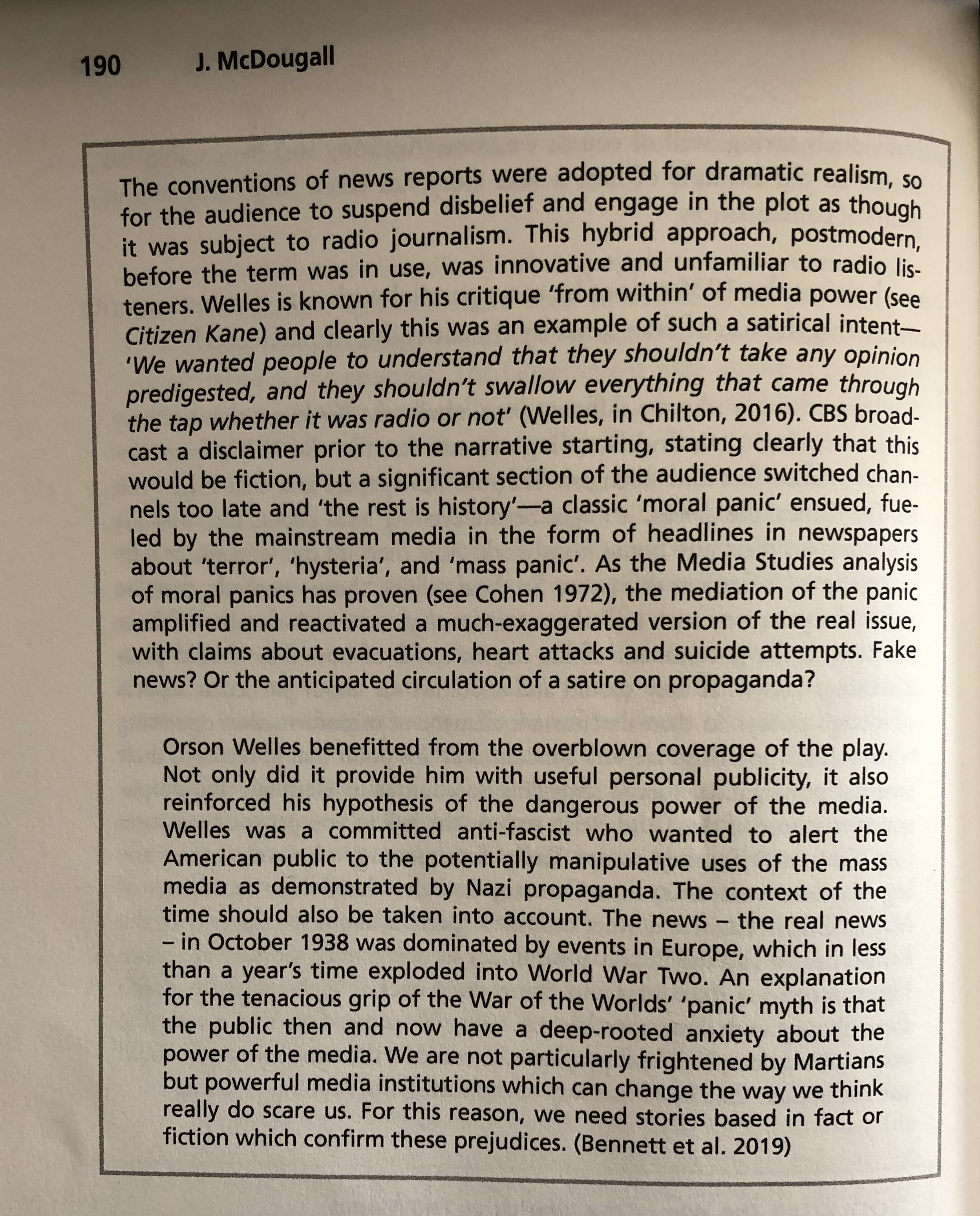
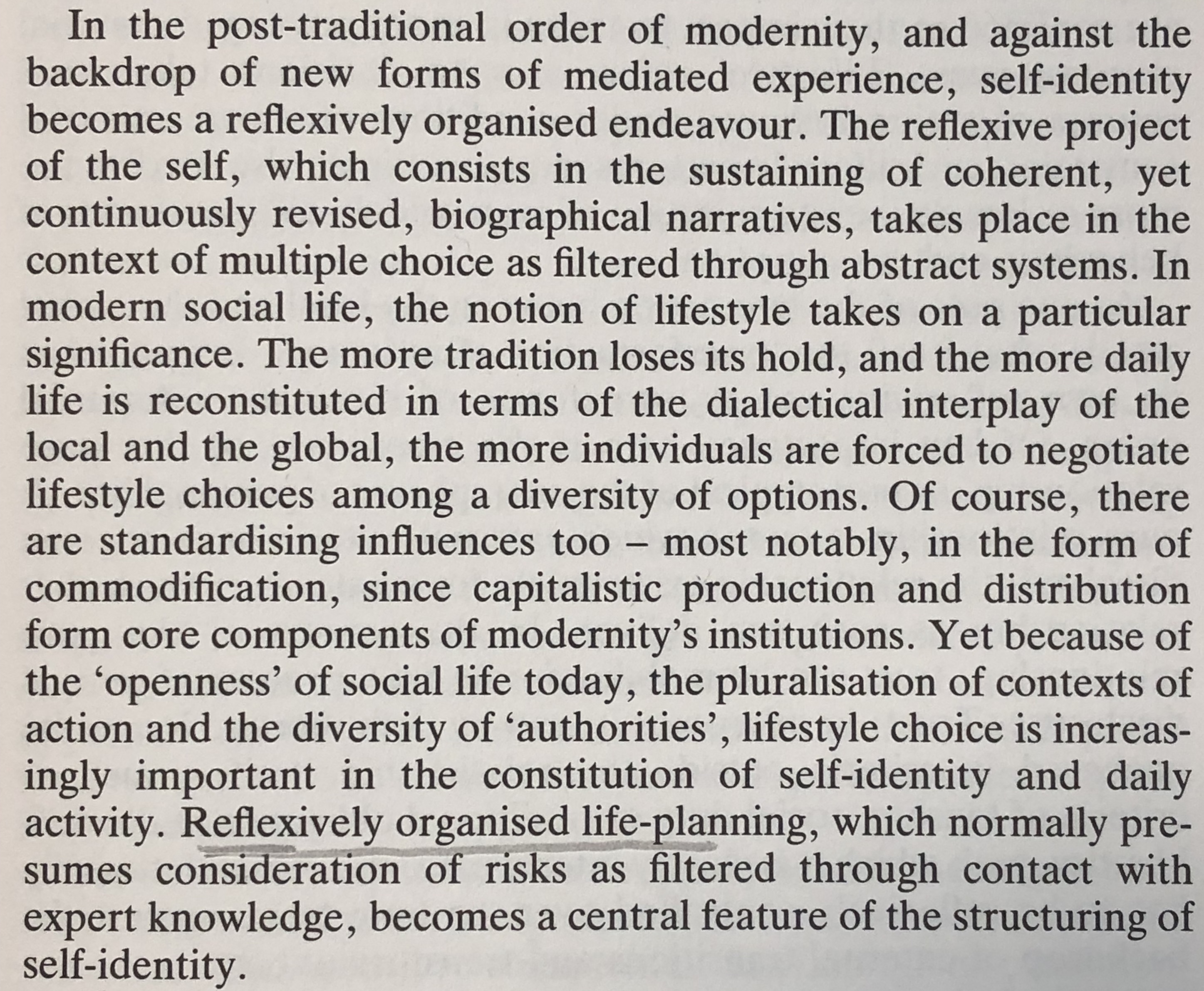
Quotes from Modernity and Self Identity: Self and Society in the Late Modern Age (Anthony Giddens)
Semiotics
Ferdinand de Saussure:
C S Pierce:
Roland Barthes:
You will also need to understand these key terms:
Answers are likely to consider:
General points:
· The significance of economic factors, including commercial and not-for-profit public funding, to media industries and their products.
· How media organisations maintain, including through marketing, varieties of audiences nationally.
· How media producers target, attract, reach, address and potentially construct audiences.
· How media industries target audiences through the content and appeal of media products and through the ways in which they are marketed, distributed and circulated. The Liberal theory of press freedom (eg summarised by Curran & Seaton)
· In this view of freedom of expression, it is the interests of the press, not of its readers nor of the subjects of its coverage, which are fundamental. (‘Free enterprise is a pre-requisite of a free press’)
· Based on the assumption that democracy is best served by the free exchange of ideas, for which freedom of expression is vital. (‘the best test of truth is the power of the thought to get itself accepted in the competition of the market’)
· In the case of the press, with certain limited exceptions, no legal restriction is placed on the right to buy or launch a newspaper. (This ensures, in liberal theory, that the press is free, diverse and representative (Curran and Seaton 2003: 346-7).
· ‘the United Kingdom regards press freedom as an absolute freedom.’ The government leaves it to the market forces to decide which press products survive’ (1992: 53).
· ‘press freedom is a property right exercised by publishers on behalf of society.’ Any other form of regulation simply distorts the market, operates against the interests of both producers and consumers, and violates the private property rights on which this whole edifice rests.
The i newspaper
· The i launched to pose a challenge to existing ‘quality’ newspapers with low cover price and tabloid format.
· In the context of declining newspaper sales it made a bold statement: “condense, re-format, repurpose – and produce a terse, intelligent summation of the day’s news that busy commuters can enjoy” (Peter Preston).
· It has battled to remain ‘cheap’ or at least ‘cheaper’: the weekday edition rising from 20p to 50p.
· Historical lineage going back to a much-missed ‘parent’ paper, the Independent, now defunct in print form: A significant number of staff joined the team from The Independent.
· It has maintained a reputation: named National Newspaper of the Year in 2015.
· Actually this link was broken when it was purchased by regional publisher Johnston Press (this has not affected its identity).
· It has a distinct ‘independent’ register, crisply edited: aimed at “readers and lapsed readers” of all ages and commuters with limited time: you don’t have to ‘identify’ yourself as a reader of a newspaper.
· Appearance is vital: USP: inside and out: compact, “matrices” for news, business and sports— small paragraphs of information which are expanded upon in full articles further on in the paper”.
· Its title reaches back to ‘independence’ but also forward to internet: i-pad, i-phone, i-player, i!
· The paper is active on social media, reinforcing its youthful feel: there is also a discounted student subscription that lasts for one academic year
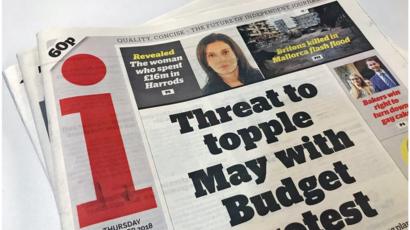
In the introduction, we explained the inadequacies of the traditional left-right line.

If we recognise that this is essentially an economic line it’s fine, as far as it goes. We can show, for example, Stalin, Mao Zedong and Pol Pot, with their commitment to a totally controlled economy, on the hard left. Socialists like Mahatma Gandhi and Robert Mugabe would occupy a less extreme leftist position. Margaret Thatcher would be well over to the right, but further right still would be someone like that ultimate free marketeer, General Pinochet.
That deals with economics, but the social dimension is also important in politics. That’s the one that the mere left-right scale doesn’t adequately address. So we’ve added one, ranging in positions from extreme authoritarian to extreme libertarian.
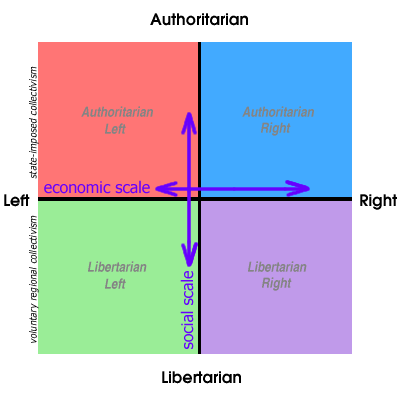
Both an economic dimension and a social dimension are important factors for a proper political analysis. By adding the social dimension you can show that Stalin was an authoritarian leftist (ie the state is more important than the individual) and that Gandhi, believing in the supreme value of each individual, is a liberal leftist. While the former involves state-imposed arbitrary collectivism in the extreme top left, on the extreme bottom left is voluntary collectivism at regional level, with no state involved. Hundreds of such anarchist communities existed in Spain during the civil war period
You can also put Pinochet, who was prepared to sanction mass killing for the sake of the free market, on the far right as well as in a hardcore authoritarian position. On the non-socialist side you can distinguish someone like Milton Friedman, who is anti-state for fiscal rather than social reasons, from Hitler, who wanted to make the state stronger, even if he wiped out half of humanity in the process.
The chart also makes clear that, despite popular perceptions, the opposite of fascism is not communism but anarchism (ie liberal socialism), and that the opposite of communism ( ie an entirely state-planned economy) is neo-liberalism (ie extreme deregulated economy)
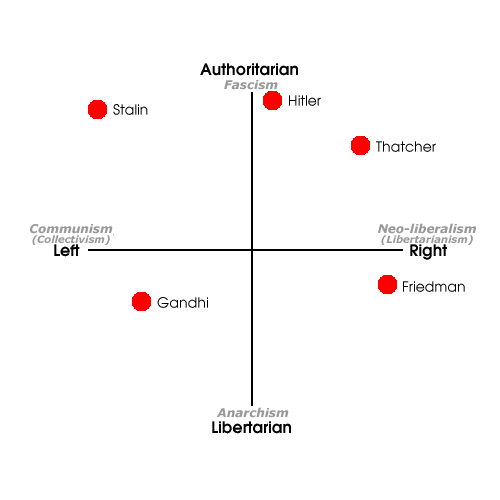
The usual understanding of anarchism as a left wing ideology does not take into account the neo-liberal “anarchism” championed by the likes of Ayn Rand, Milton Friedman and America’s Libertarian Party, which couples social Darwinian right-wing economics with liberal positions on most social issues. Often their libertarian impulses stop short of opposition to strong law and order positions, and are more economic in substance (ie no taxes) so they are not as extremely libertarian as they are extremely right wing. On the other hand, the classical libertarian collectivism of anarcho-syndicalism ( libertarian socialism) belongs in the bottom left hand corner.
In our home page we demolished the myth that authoritarianism is necessarily “right wing”, with the examples of Robert Mugabe, Pol Pot and Stalin. Similarly Hitler, on an economic scale, was not an extreme right-winger. His economic policies were broadly Keynesian, and to the left of some of today’s Labour parties. If you could get Hitler and Stalin to sit down together and avoid economics, the two diehard authoritarians would find plenty of common ground.
U.S. neo-conservatives, with their commitment to high military spending and the global assertion of national values, tend to be more authoritarian than hard right. By contrast, neo-liberals, opposed to such moral leadership and, more especially, the ensuing demands on the tax payer, belong to a further right but less authoritarian region. Paradoxically, the “free market”, in neo-con parlance, also allows for the large-scale subsidy of the military-industrial complex, a considerable degree of corporate welfare, and protectionism when deemed in the national interest. These are viewed by neo-libs as impediments to the unfettered market forces that they champion.

Quotations:
Regulation, state or free market
Habermas’ Public Sphere theory
Mass Media in Public Interest
James Curran = created the book ‘Mass Media and democracy’
| Technology and Newspapers | ||
| Production | Distribution | Consumption |
| – Reported by journalists – Sent in by consumers – Laptop/computer – Word processing software – telephone – pen and paper – printers – send out journalists to create the article/report – audio recorder – camera/ digital camera – photographers – email software to gather information – editing software | – paper format as a newspaper – free newspapers that are available in airports – distributed by lorries, vans and cars – air cargo distribution – distributed into shops, bookshops and newsagents – large scale printing press – stacks – shelves – display cases – paper rounds by the “paper boy/girl” | – available in paper form – available in digital form -bought from shops – available to read digital copies on electronic devices and mobile devices. – daily subscriptions – premium subscriptions (with perks such as free digital copy included) |
Noam Chomsky – Manufacturing Consent

This is a book that is written by Chomsky and Edward S Herman, which proposes that the mass communication medias of the US are “effective and powerful ideological institutions that carry out a system-supportive propaganda function, by reliance on market forces, internalized assumptions, and self-censorship, and without overt coercion”.
5 Filters of Mass Media
Agenda setting – the creation of public issues, but can be filtered what articles are covered in order to emphasise and spread propaganda about a certain topic and issues that might interest their target reader.
Framing – how something is presented to the audience. Factors that influence framing include Gender, Race, Politics, Age, Society/Cultural trends and the economic issues and the influence of sponsors and money.
Myth making – when you create a statement or belief that hasn’t been backed up by anything, therefore people are hesitant to believe, meaning some people believe it but some people don’t.
The Sociology of News Production